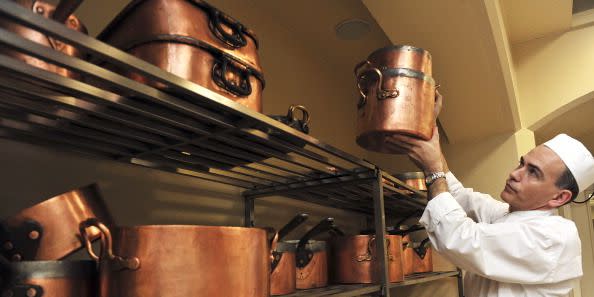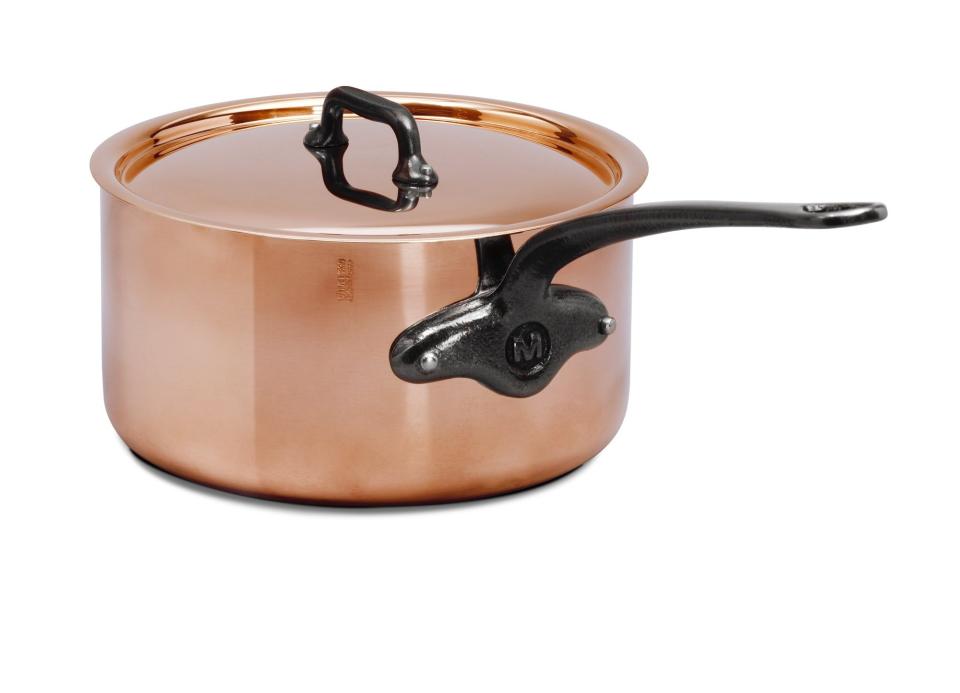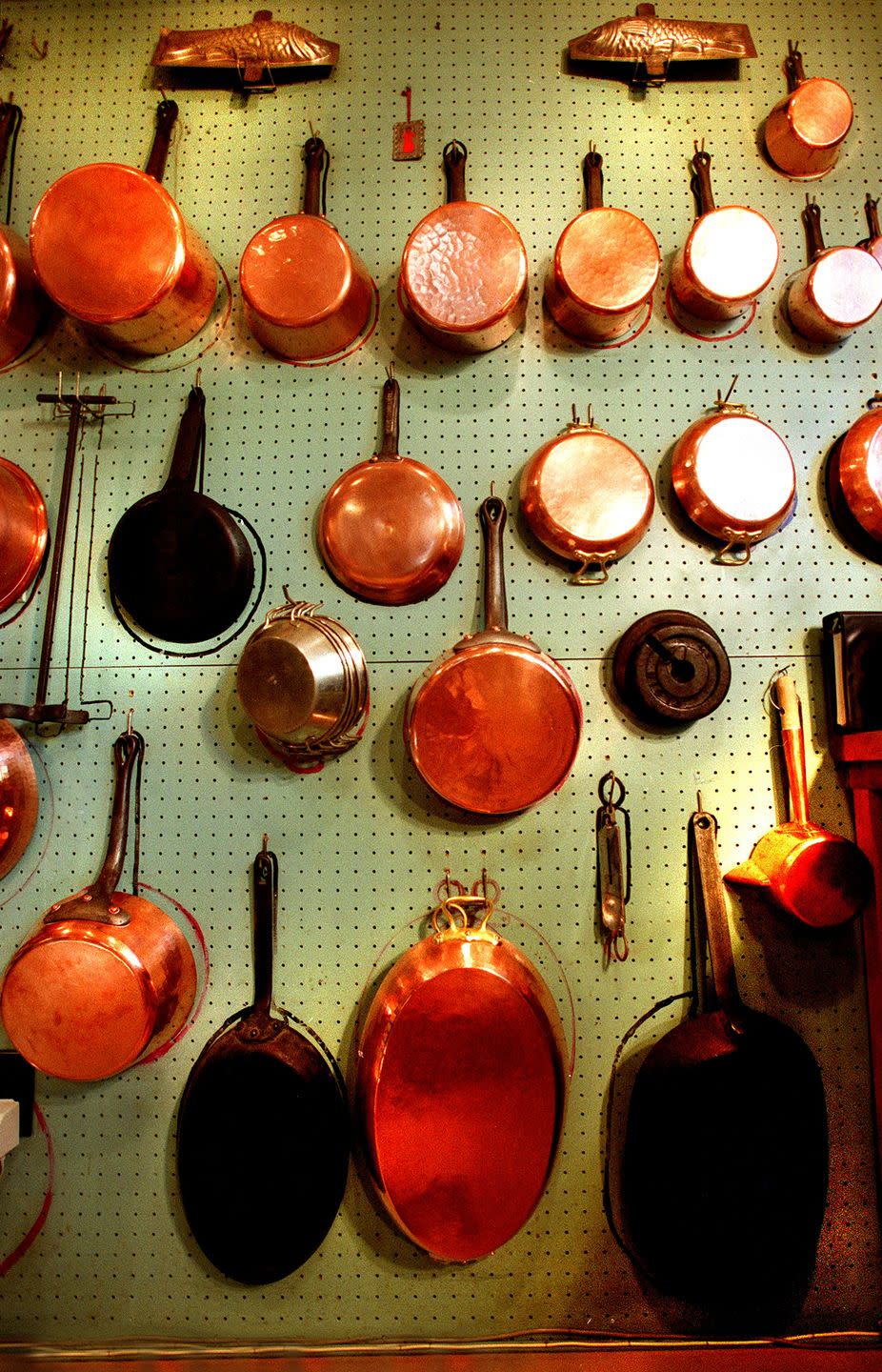An Obsessive's Guide to Copper Pots

"Hearst Magazines and Yahoo may earn commission or revenue on some items through the links below."
Let me preface this by saying, right up front, that what I’m going to recommend is a huge pain in the ass. What I’m going to tell you to do is to upgrade your pots and pans to heavy-duty solid copper, the kind old French restaurants and hotel kitchens use. They will be (are) ridiculously heavy to lift. They tarnish. Some have bare cast-iron handles, which rust if you don’t dry them off after you do the dishes. They’re lined with soft tin, and if you overheat a pan on the stove, you’ll blister the interior. Metal utensils are off-limits. Don’t even think about putting them in the dishwasher.
Why on earth would you tolerate such fuss? Well, the thing about copper is that it’s the best conductor of heat of almost any metal. A commercial-grade copper pan—typically about 2 millimeters thick—soaks up Btu’s from a gas flame like crazy and spreads them around super-evenly. But it is also so conductive that, if you yank that pan off the heat, the cooking stops in a hurry. What a copper pan gives you, especially when you’re working with a skillet, is control. You can crank it up and brown your chop or cutlet, then turn it down for the low slow cook, then bring it back up to finish the pan sauce. It’s harder to burn anything and it’s easier to get it just right. The tin lining is not quite as nonstick as modern polymers, but it is surprisingly close; you might call it low-stick. Also it’s not plastic, and it won’t flake off in your food the way Teflon and its successors will.
Copper pans are also, if you keep them on view in your kitchen, ridiculously beautiful industrial objects. Some cooks scrub off the oxidation from the exterior after every few uses and polish them back to bright metal; others let it all turn brown like old pennies. The tin interiors glisten like mercury when new, and gradually turn a pewter gray over time. Eventually they wear down through; once a decade, give or take, you’ll have to send them off for re-tinning, a process that only a few firms in America still do. The one I use is East Coast Tinning, in Rhode Island, where a guy named Jim Hamann who clearly loves this old industrial idiom. He’ll turn around most jobs in a couple of weeks.
If the whole re-tinning business seems tiresome, you can, nowadays, buy copper pans with a thin stainless-steel lining. They’re good, and the stainless is of course basically indestructible. But it is also less conductive than the copper, and more prone to sticking. You’re basically trading some of the pleasures of cooking in copper for convenience and low maintenance, and I wouldn’t begrudge you if you do. But my loyalties are with the old style, partly because I have already made the investment in a lot of indestructible heavy metal, and partly because I just like the continuity of working at the stove the way a couple of hundred years’ worth of cooks did before me.
For many generations, most copper pans have been produced in one town called Villedieu-les-Poêles, which translates to—and although this sounds like a parody of extreme Frenchness, I am not making it up—“God-City of the Frying Pans.” Its metalworkers were once known far and wide for superb workmanship and severe hearing damage. (All that hammering in the shops was highly destructive, in the days before earplugs and workplace regulation.) The most prominent maker in Villedieu is a company called Mauviel founded in 1830. The town also supplies first-rate copper pans to Dehillerin, the ancient, beloved, no-nonsense store on the Rue Coquillière in Paris. It’s where Julia Child bought hers and where Chuck Williams got the germ of an idea that he brought back to Sonoma. When I visited last year, I saw a group of commercial stock pots, dropped off for re-tinning, that were the size of truck tires.

M'200 CI Saucepan With Lid , 7.9 In
mauviel-usa.com
mauviel-usa.comYou can also get American copper. Hamann has a great-looking line of his own for which he revived a nineteenth-century maker’s name, Duparquet. There are a couple of makers in and around New York, too: an old company called Hammersmith, formerly headquartered right under the Brooklyn Bridge and now in New Jersey, and a startup called Brooklyn Copper Cookware whose pots have great sculptural handles. (BCC’s cookware production is erratic, in small batches. Sign up for the founder’s insanely garrulous e-mails at your own risk.)
The thing about copper pots, though, is that they are almost indestructible, so there’s no loss in buying them secondhand or even antique. I have bought pans that are decades old, scrubbed off the crud and sent them off for new tin, and started cooking on them as if they had been made yesterday. (Names to look for in your eBay searches: Duparquet, Waldow, Leon Jaeggi, Bridge Kitchenware, Gaillard.) Should you want to dive in deep, there is a bottomless well of collectors’ detail and gleaming photographs at vintagefrenchcopper.com. One pot in my kitchen, I learned from her site, was made around 1885. Still works.

And for the true connoisseur: There are a very few pans out there that are lined not with tin or stainless but with a thin plating of pure sterling silver, which is even more conductive than copper or tin; is more nonstick than either; and, unlike tin, cannot be overheated to the point where it’ll soften over a gas flame. I lucked into one awhile back at a comically low price, and you can see it in the video at this link, which I made recently as I tried to reproduce a notorious omelet. It is the closest I will ever come to making breakfast with jewelry.
You Might Also Like

